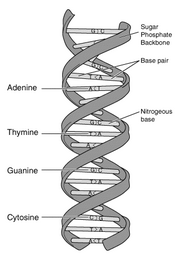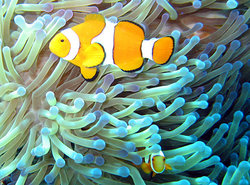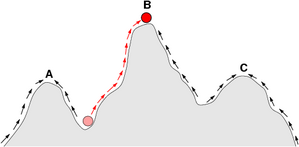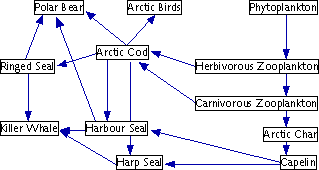Difference between revisions of "Biology" - New World Encyclopedia
Rick Swarts (talk | contribs) |
Rick Swarts (talk | contribs) m |
||
| Line 2: | Line 2: | ||
| − | '''Biology''' is the "science of life," or the study of living and once-living things in all their forms, whether microscopic structures of a single-celled organism or the study of an entire [[ecosystem]] with millions of interacting organisms, whether one organism's life history or the history of many | + | '''Biology''' is the "science of life," or the study of living and once-living things in all their forms, whether microscopic structures of a single-celled organism or the study of an entire [[ecosystem]] with millions of interacting organisms, whether one organism's life history or the history of many [[species]] over eons of time. Sometimes referred to as "life science," biology is concerned with the characteristics and behaviors of organisms, how [[species]] and individuals come into existence, and the interactions they have with each other and with the [[natural environment|environment]]. The term itself is derived from Greek and is generally translated "study of life" (see below). |
| − | Biology encompasses a broad spectrum of academic fields that are often viewed as independent disciplines. Together, they study life over a wide range of orders of magnitude | + | Biology encompasses a broad spectrum of academic fields that are often viewed as independent disciplines. Together, they study life over a wide range of orders of magnitude. |
Life is studied at the [[atom]]ic and [[molecule|molecular]] scale in [[molecular biology]], [[biochemistry]], and [[molecular genetics]]. At the level of the [[cell (biology)|cell]], it is studied in [[cell biology]], and at [[multicellular]] scales, it is examined in [[physiology]], [[anatomy]], and [[histology]]. [[Developmental biology]] studies life at the level of the development or [[ontogeny]] of an individual organism. | Life is studied at the [[atom]]ic and [[molecule|molecular]] scale in [[molecular biology]], [[biochemistry]], and [[molecular genetics]]. At the level of the [[cell (biology)|cell]], it is studied in [[cell biology]], and at [[multicellular]] scales, it is examined in [[physiology]], [[anatomy]], and [[histology]]. [[Developmental biology]] studies life at the level of the development or [[ontogeny]] of an individual organism. | ||
Moving up the scale towards more than one organism, [[genetics]] considers how [[heredity]] works between parent and offspring. [[Ethology]] considers group behavior of more than one individual. [[Population genetics]] looks at the level of an entire [[population]], and [[systematics]] considers the multi-species scale of [[lineage]]s. Interdependent populations and their [[Habitat (ecology)|habitats]] are examined in [[ecology]] and [[evolutionary biology]]. A speculative new field is [[astrobiology]] (or xenobiology) which examines the possibility of life beyond the Earth. | Moving up the scale towards more than one organism, [[genetics]] considers how [[heredity]] works between parent and offspring. [[Ethology]] considers group behavior of more than one individual. [[Population genetics]] looks at the level of an entire [[population]], and [[systematics]] considers the multi-species scale of [[lineage]]s. Interdependent populations and their [[Habitat (ecology)|habitats]] are examined in [[ecology]] and [[evolutionary biology]]. A speculative new field is [[astrobiology]] (or xenobiology) which examines the possibility of life beyond the Earth. | ||
| + | |||
| + | ** Add — paleobotay, botany, zoology *** etc.** | ||
| + | |||
<div class="thumb tright"> | <div class="thumb tright"> | ||
<div style="width:200px;"> | <div style="width:200px;"> | ||
Revision as of 03:03, 16 October 2005
Note: This is only a very rough draft, with notes. Please do not edit this article until the actual article is complete — i.e., when this notice is removed. You may add comments on what you would like to see included. Rick Swarts 00:05, 28 Sep 2005 (UTC)
Biology is the "science of life," or the study of living and once-living things in all their forms, whether microscopic structures of a single-celled organism or the study of an entire ecosystem with millions of interacting organisms, whether one organism's life history or the history of many species over eons of time. Sometimes referred to as "life science," biology is concerned with the characteristics and behaviors of organisms, how species and individuals come into existence, and the interactions they have with each other and with the environment. The term itself is derived from Greek and is generally translated "study of life" (see below).
Biology encompasses a broad spectrum of academic fields that are often viewed as independent disciplines. Together, they study life over a wide range of orders of magnitude.
Life is studied at the atomic and molecular scale in molecular biology, biochemistry, and molecular genetics. At the level of the cell, it is studied in cell biology, and at multicellular scales, it is examined in physiology, anatomy, and histology. Developmental biology studies life at the level of the development or ontogeny of an individual organism.
Moving up the scale towards more than one organism, genetics considers how heredity works between parent and offspring. Ethology considers group behavior of more than one individual. Population genetics looks at the level of an entire population, and systematics considers the multi-species scale of lineages. Interdependent populations and their habitats are examined in ecology and evolutionary biology. A speculative new field is astrobiology (or xenobiology) which examines the possibility of life beyond the Earth.
- Add — paleobotay, botany, zoology *** etc.**
Principles of biology
While biology is unlike physics in that it does not usually describe biological systems in terms of objects which obey immutable physical laws described by mathematics, it is nevertheless characterized by several major principles and concepts which include: universality, evolution, diversity, continuity, homeostasis and interactions.
Universality: Biochemistry, cells and the genetic code

Main articles: Life
All organisms (viruses not included) consist of cells, which in turn, are based on a common carbon-based biochemistry. All organisms pass on their heredity via the genetic material which is based upon the nucleic acids such as DNA using a nearly universal genetic code. In development the theme of universal processes is also present, for example in most metazoan organisms the basic steps of the early embryo development share similar morphological stages and include similar genes.
Evolution: A common organizing principle of biology
Main article: Evolution
One of the central, organizing concepts in biology is that all life has descended from a common origin through a process of evolution. Indeed, it is one of the reasons that biological organisms exhibit the striking similarity of units and processes discussed in the previous section. Charles Darwin established evolution as a viable theory by articulating its driving force: natural selection. (Alfred Russell Wallace is commonly recognized as the co-discoverer of this concept). Genetic drift was embraced as an additional mechanism in the so-called modern synthesis. The evolutionary history of a species—which tells the characteristics of the various species from which it descended—together with its genealogical relationship to every other species is called its phylogeny. Widely varied approaches to biology generate information about phylogeny. These include the comparisons of DNA sequences conducted within molecular biology or genomics, and comparisons of fossils or other records of ancient organisms in paleontology. Biologists organize and analyze evolutionary relationships through various methods, including phylogenetics, phenetics, and cladistics. Major events in the evolution of life, as biologists currently understand them, are summarized on this evolutionary timeline.
- Another organizing principle: the Unity, harmony, and cooperation. Example: trees giving off oxygen, animals CO2; heribovers, carnivores, top carnivores, decomposing organisms; plants, herbivores, etc.; symbionts, etc.
Another organizing principle: Dual purpose
Note above Dobzansky's quote on evoltuion that nothing in biology makes sense except in the light of evolution.
Diversity: The variety of living organisms
Despite the underlying unity, life exhibits an astonishing wide diversity in morphology, behavior and life histories. In order to grapple with this diversity, biologists attempt to classify all living things. This scientific classification should reflect the evolutionary trees (phylogenetic trees) of the different organisms. Such classifications are the province of the disciplines of systematics and taxonomy. Taxonomy puts organisms in groups called taxa, while systematics seeks their relationships.
Traditionally, living things were divided into five kingdoms:
However, this five-kingdom system is now considered by many to be outdated. More modern alternatives generally begin with the three-domain system:
These domains reflect whether cells have nuclei or not as well as differences in cell exteriors. There is also a series of intracellular "parasites" that are progressively less alive in terms of being metabolically active:
Continuity: The common descent of life
Main article: Common descent
A group of organisms is said to have common descent if they have a common ancestor. All existing organisms on Earth are descended from a common ancestor or ancestral gene pool. This "last universal common ancestor, that is, the most recent common ancestor of all organisms, is believed to have appeared about 3.5 billion years ago (see: origin of life).
The notion that "all life [is] from [an] egg" (from the Latin "Omne vivum ex ovo") is a foundational concept of modern biology, it means that there has been an unbroken continuity of life from the initial origin of life to the present time. Up into the 19th century it was commonly believed that life forms can appear spontaneously under certain conditions (see abiogenesis). The universality of the genetic code is generally regarded by biologists as definitive evidence in favor of the theory of universal common descent (UCD) for all bacteria, archaea, and eukaryotes (see Three domain system).
Homeostasis: Adapting to change
Main article: Homeostasis
Homeostasis is the property of an open system to regulate its internal environment so as to maintain a stable condition, by means of multiple dynamic equilibrium adjustments controlled by interrelated regulation mechanisms. All living organisms, whether unicellular or multicellular exhibit homeostasis. Homeostasis can manifest itself at the cellular level through the maintenance of a stable internal acidity (pH); at the organismal level warm-blooded animals maintain a constant internal body temperature; and at the level of the ecosystem, for example when atmospheric carbon dioxide levels rise, plants are theoretically able to grow healthier and thus remove more carbon dioxide from the atmosphere. Tissues and organs can also maintain homeostasis.
Interactions: Groups and environments

Every living thing interacts with other organisms and its environment. One of the reasons that biological systems can be difficult to study is that there are so many different possible interactions with other organisms and the environment. A microscopic bacterium responding to a local gradient in sugar is as much responding to its environment as a lion is responding to its environment when it is searching for food in the African savannah. Within a particular species behaviors can be co-operative, aggressive, parasitic or symbiotic. Matters become more complex still when two or more different species interact in an ecosystem, and is the province of ecology.
Scope of biology
Main article: List of biology disciplines
Biology has become such a vast research enterprise that it is not generally studied as a single discipline, but as a number of clustered sub-disciplines. We consider four broad groupings here. The first broad group consists of disciplines that study the basic structures of living systems: cells, genes etc., a second grouping considers the operation of these structures at the level of tissues, organs and bodies; a third grouping considers organisms and their histories; a final constellation of disciplines focuses on the interactions. It is important to note, however, that these boundaries and groupings and descriptions are a simplified description of biological research. In reality the boundaries between disciplines are very fluid and most disciplines borrow techniques from each other frequently. For example evolutionary biology leans heavily on techniques from molecular biology to determine DNA sequences which assist in understanding the genetic variation of a population; and physiology borrows extensively from cell biology in describing the function of organ systems.
Structure of life
Main articles: Molecular biology, Cell biology, Genetics, Developmental biology
Molecular biology is the study of biology at a molecular level. The field overlaps with other areas of biology, particularly genetics and biochemistry. Molecular biology chiefly concerns itself with understanding the interactions between the various systems of a cell, including the interrelationship of DNA, RNA and protein synthesis and learning how these interactions are regulated.
Cell biology studies the physiological properties of cells, as well as their behaviors, interactions, and environment; this is done both on a microscopic and molecular level. Cell biology researches both single-celled organisms like bacteria and specialized cells in multicellular organisms like humans.
Understanding the composition of cells and how cells work is fundamental to all of the biological sciences. Appreciating the similarities and differences between cell types is particularly important to the fields of cell and molecular biology. These fundamental similarities and differences provide a unifying theme, allowing the principles learned from studying one cell type to be extrapolated and generalized to other cell types.
Genetics is the science of genes, heredity, and the variation of organisms. In modern research, genetics provides important tools in the investigation of the function of a particular gene, e.g. analysis of genetic interactions. Within organisms, genetic information generally is carried in chromosomes, where it is represented in the chemical structure of particular DNA molecules.
Genes encode the information necessary for synthesizing proteins, which in turn play a large role in influencing the final phenotype of the organism, although in many instances do not completely determine it.
Developmental biology studies the process by which organisms grow and develop. Originating in embryology, today developmental biology studies the genetic control of cell growth, differentiation and "morphogenesis," which is the process that gives rise to tissues, organs and anatomy. Model organisms for developmental biology include the round worm Caenorhabditis elegans, the fruit fly Drosophila melanogaster, the zebrafish Brachydanio rerio, the mouse Mus musculus, and the weed Arabidopsis thaliana.
Physiology of organisms
Main articles: Physiology, Anatomy
Physiology studies the mechanical, physical, and biochemical processes of living organisms, by attempting to understand how all the structures function as a whole. The theme of 'structure to function' is central to biology. Physiology studies have traditionally been divided into plant physiology and animal physiology but the principles of physiology are universal, no matter what particular organism is being studied. For example, what is learned about the physiology of yeast cell can also apply to human cells. The field of animal physiology extends the tools and methods of human physiology to non-human animal species. Plant physiology also borrows techniques from both fields.
Anatomy is an important part of physiology and considers how organ systems in animals such as the nervous, immune, endocrine, respiratory and circulatory systems function and interact. The study of these systems is shared with the medically oriented disciplines of neurology, immunology and the like.
Diversity and evolution of organisms

Main articles: Evolutionary biology, Botany, Zoology
Evolutionary biology is concerned with the origin and descent of species, as well as their change over time, i.e. their evolution. Evolutionary biology is an inclusive field because it includes scientists from many traditional taxonomically-oriented disciplines. For example, it generally includes scientists who may have a specialist training in particular organisms such as mammalogy, ornithology, or herpetology but use those organisms as systems to answer general questions in evolution. It also generally includes paleontologists who use fossils to answer questions about the mode and tempo of evolution, as well as theoreticians in areas such as population genetics and evolutionary theory. In the 1990s developmental biology made a re-entry into evolutionary biology from its initial exclusion from the modern synthesis through the study of evolutionary developmental biology. Related fields which are often considered part of evolutionary biology are phylogenetics, systematics and taxonomy.
The two major traditional taxonomically-oriented disciplines are botany and zoology. Botany is the scientific study of plants. Botany covers a wide range of scientific disciplines that study the growth, reproduction, metabolism, development, diseases, and evolution of plant life. Zoology is the discipline which involves the study of animals, which includes the physiology of animals is studied under various fields including anatomy and embryology. The common genetic and developmental mechanisms of animals and plants is studied in molecular biology, molecular genetics and developmental biology. The ecology of animals is covered under behavioral ecology and other fields.
Classification of life
The dominant classification system is called Linnaean taxonomy, which includes ranks and binomial nomenclature. How organisms are named is governed by international agreements such as the International Code of Botanical Nomenclature (ICBN), the International Code of Zoological Nomenclature (ICZN), and the International Code of Nomenclature of Bacteria (ICNB). A fourth Draft BioCode was published in 1997 in an attempt to standardize naming in the three areas, but it does not appear to have yet been formally adopted. The International Code of Virus Classification and Nomenclature (ICVCN) remains outside the BioCode.
Interactions of organisms
Main articles: Ecology, Ethology, Behavior
Ecology studies the distribution and abundance of living organisms, and the interactions between organisms and their environment. The environment of an organism includes both its habitat, which can be described as the sum of local abiotic factors like climate and geology, as well as the other organisms which share its habitat. Ecological systems are studied at several different levels from individuals and populations to ecosystems and biosphere level. Ecology is a multi-disciplinary science, drawing on many other branches of science.
Ethology studies animal behavior (particularly of social animals such as primates and canids), and is sometimes considered as a branch of zoology. Ethologists have been particularly concerned with the evolution of behavior and the understanding of behavior in terms of the theory of natural selection. In one sense the first modern ethologist was Charles Darwin, whose book The expression of the emotions in animals and men influenced many ethologists.
History of the word "biology"
from the Greek words "βιos" bios = life and "λoγos", logos = reasoned account). : or reason or logic or human knowledge
the word biology comes from the Greek words "βιos" bios (translated as "life") and "λoγos", logos (which may be translated as "reasoned account," "logic," or "human knowledge," or just "study of.")
biology states bios and logos (description) zoology states zoo and -logy (from Greek "logia" from "legein — to speak) meaning science, theory of
logy (from Greek logia, from legein, to speak) — science of
geology states from geo and logos, a description, from legein, to speak
ecology states from house and "logy"
noted that ology is back-formatin, with -logy derived from teh Greek suffix -***** (-logia, speaking, and from ***** (legein), to speak.. The root workd -log comes from the Greek word Logos, denoted a discourse, science., etc.
Formed by combining the Greek βίος (bios), meaning 'life', and λόγος (logos), meaning 'study of', the word "biology" in its modern sense seems to have been introduced independently by Gottfried Reinhold Treviranus (Biologie oder Philosophie der lebenden Natur, 1802) and by Jean-Baptiste Lamarck (Hydrogéologie, 1802). The word itself is sometimes said to have been coined in 1800 by Karl Friedrich Burdach, but it appears in the title of Volume 3 of Michael Christoph Hanov's Philosophiae naturalis sive physicae dogmaticae: Geologia, biologia, phytologia generalis et dendrologia, published in 1766.
History
Main articles: History of biology, History of medicine, History of genetics
Major discoveries in biology include:
- Cell theory
- Germ theory of disease
- Genetics
- Evolution
- DNA
Related topics
Main articles: List of biology topics
| Topics related to biology (Category) | |
|---|---|
| People and history | Biologist - Notable biologists - History of biology - Nobel Prize in Physiology or Medicine - Timeline of biology and organic chemistry - List of geneticists and biochemists |
| Institutions, publications | NASA Ames Research Center - Bachelor of Science - Publications |
| Terms and phrases | Omne vivum ex ovo - In vivo - In vitro - In utero - In silico |
| Related disciplines | Medicine (Physician) - Physical anthropology |
| Outstanding problems | Origin of life - Unsolved problems in biology |
| Other | List of technologies - List of conservation topics |
External links
- BioCode: A proposal for organism naming.
- Recent Advances In Biological Research
- Biology Discussion Forum
- Biology Online: One person-maintained site with tutorials.
- EverythingBio : An online source for everything biology related.
- Kimball's Biology Pages: An online searchable textbook.
- NCBI Open-Access Books
- PhyloCode, [1]
- The Journal of Biology: A small, but free, research journal
- The Tree of Life: A multi-authored, distributed Internet project containing information about phylogeny and biodiversity.
- Biology News Net: Daily updated Biology News.
- The Public Library of Science: Biology: A newer, but more ambitious free research journal.
- The WWW Virtual Library: Biosciences
- BioOne Bioscience research journals.
Further reading
- Lynn Margulis, Five Kingdoms: An Illustrated Guide to the Phyla of Life on Earth, 3rd ed., St. Martin's Press, 1997, paperback, ISBN 0805072527 (many other editions)
- Neil Campbell, Biology (7th edition), Benjamin-Cummings Publishing Company, 2004, hardcover, ISBN 080537146X
Credits
New World Encyclopedia writers and editors rewrote and completed the Wikipedia article in accordance with New World Encyclopedia standards. This article abides by terms of the Creative Commons CC-by-sa 3.0 License (CC-by-sa), which may be used and disseminated with proper attribution. Credit is due under the terms of this license that can reference both the New World Encyclopedia contributors and the selfless volunteer contributors of the Wikimedia Foundation. To cite this article click here for a list of acceptable citing formats.The history of earlier contributions by wikipedians is accessible to researchers here:
The history of this article since it was imported to New World Encyclopedia:
Note: Some restrictions may apply to use of individual images which are separately licensed.





